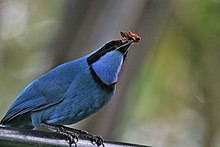Cyanolyca turcosa
| Turquoise jay | |
|---|---|
 |
|
| Scientific classification | |
| Kingdom: | Animalia |
| Phylum: | Chordata |
| Class: | Aves |
| Order: | Passeriformes |
| Family: | Corvidae |
| Genus: | Cyanolyca |
| Species: | C. turcosa |
| Binomial name | |
|
Cyanolyca turcosa (Bonaparte, 1853) |
|
| Synonyms | |
|
|
The turquoise jay (Cyanolyca turcosa) is a species of bird in the family Corvidae.
The turquoise jay is a vibrant blue jay with a black face mask and collar. It is found exclusively in South America throughout southern Colombia, Ecuador, and northern Peru. The turquoise jay prefers a humid habitat of montane evergreen forests and elfin forests with both primary and secondary growth. This bird is omnivorous and is known to eat insects, berries, eggs, and young birds of other species. Turquoise jays are nonmigratory and tend to travel in mixed flocks.
The order Passeriformes, commonly referred to as “perching birds,” is perhaps the largest and most diverse order of birds. These birds are found worldwide, excluding Antarctica, but have their highest concentration in the tropics. Their sizes range from just a few grams to over a kilogram in weight, and they are generally colorful songbirds.
The family Corvidae is in the order Passeriformes and includes the jays, magpies, and crows. Most of the birds are strongly built, are stout-billed, and are some of the largest birds in Passeriformes order. In most cases there exists no sexual dimorphism. Corvids have loud, harsh voices and an advanced social organization. Individuals in a colony will take care of one another and generally a pair will mate for life. Corvids can be destructive; often they rob nests and ruin crops, however they are extremely intelligent and are resourceful scavengers. There are over 120 known species in the family Corvidae.
Similar species include the beautiful jay, the black-collared jay, and the white-collared jay. The turquoise jay is sympatric with the black-collared jay; both inhabit northwestern South America, though the black-collared jay is less green in color and has a much longer tail. The white-collared jay is also prevalent in northwestern South America, but differs in appearance from the turquoise jay by a white forecrown, black undertail, thin white collar, and general darker blue color. The beautiful jay is a rare jay that exists only on a thin strip of the western Andes between Colombia and Ecuador. It is different from the turquoise jay by a darker color overall, smaller size, and the absence of a black collar. The turquoise jay has no subspecies.
...
Wikipedia

